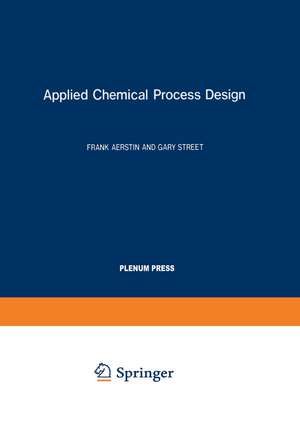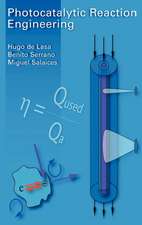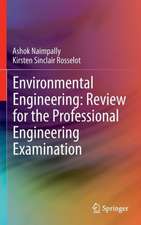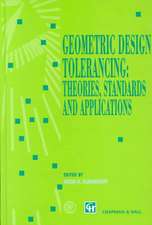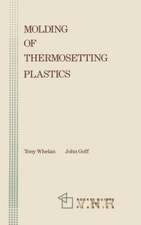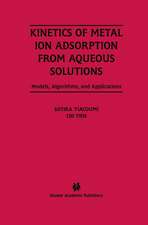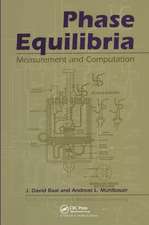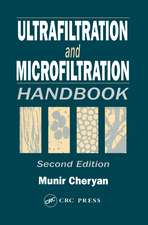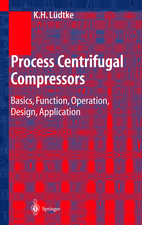Applied Chemical Process Design
Autor F. Aerstin, G. Streeten Limba Engleză Paperback – 4 noi 2011
Preț: 894.61 lei
Preț vechi: 1090.99 lei
-18% Nou
Puncte Express: 1342
Preț estimativ în valută:
171.24€ • 186.06$ • 143.93£
171.24€ • 186.06$ • 143.93£
Carte tipărită la comandă
Livrare economică 22 aprilie-06 mai
Preluare comenzi: 021 569.72.76
Specificații
ISBN-13: 9781461339786
ISBN-10: 1461339782
Pagini: 316
Ilustrații: 312 p.
Dimensiuni: 170 x 244 x 17 mm
Greutate: 0.55 kg
Ediția:Softcover reprint of the original 1st ed. 1978
Editura: Springer Us
Colecția Springer
Locul publicării:New York, NY, United States
ISBN-10: 1461339782
Pagini: 316
Ilustrații: 312 p.
Dimensiuni: 170 x 244 x 17 mm
Greutate: 0.55 kg
Ediția:Softcover reprint of the original 1st ed. 1978
Editura: Springer Us
Colecția Springer
Locul publicării:New York, NY, United States
Public țintă
ResearchDescriere
Development of a new chemical plant or process from concept evaluation to profitable reality is often an enormously complex problem. Generally, a plant-design project moves to completion through a series of stages which may include inception, preliminary evaluation of economics and market, data development for a final design, final economic evaluation, detailed engineering design, procurement, erection, startup, and pro duction. The general term plant design includes all of the engineering aspects involved in the development of either a new, modified, or expanded industrial plant. In this context, individuals involved in such work will be making economic evaluations of new processes, designing individual pieces of equipment for the proposed new ventures, or developing a plant layout for coordination of the overall operation. Because of the many design duties encountered, the engineer involved is many times referred to as a design engineer. If the latter specializes in the economic aspects of the design, the individual may be referred to as a cost engineer. On the other hand, if he or she emphasizes the actual design of the equipment and facilities necessary for carrying out the process, the individual may be referred to as a process design engineer. The material presented in this book is intended to aid the latter in developing rapid chemical designs without becoming unduly involved in the often complicated theoretical underpinnings of these useful notes, charts, tables, and equations.
Cuprins
Conversion Tables.- 1. Agitation and Mixing.- 1.1. Agitators.- 1.2. Motionless Mixers.- 2. Cooling Towers.- 3. Decanters.- 4. Distillation.- 4.1. Basic Laws.- 4.2. Shortcut Method—Optimum Trays and Optimum Reflux Ratio.- 4.3. Flash Vaporization.- 4.4. Selection of Internals.- 4.5. Tray Column Diameter.- 4.6. Tray Overall Efficiency.- 4.7. Packed Column Design.- 4.8. Packed Column Diameter and Pressure Drop.- 5. Economic Evaluation.- 6. Fluid Flow.- 6.1. Fluid Flow—Single Phase.- 6.2. Fluid Flow—Two Phase.- 6.3. Flow through Orifices.- 7. Gas-Solid Separations.- 8. Heat Transfer.- 8.1. Heat Transfer Coefficients.- 8.2. Heat Losses from Tanks.- 8.3. Heating of Process Piping and Vessels—Heat Losses from Insulated Pipelines.- 8.4. Heating of Process Piping and Vessels—Steam Tracing.- 8.5. Heating of Process Piping and Vessels—Dowtherm SR-1 Tracing.- 8.6. Double Pipe Exchangers.- 8.7. Shell and Tube Heat Exchangers.- 8.8. Heat Transfer Coefficient in Agitated Vessels.- 8.9. Falling Film Coefficients.- 8.10. Reboilers and Vaporizers.- 8.11. Condensers.- 8.12. Air-Cooled Heat Exchangers.- 8.13. Unsteady-State Heat Transfer.- 9. Hydroclones.- 10. Materials.- 11. Physical Properties.- 12. Dimensions and Properties of Piping.- 13. Pump Sizing.- 14. Safety Relief Valves and Rupture Disks.- 15. Steam Ejectors for Vacuum Service.- 16. Tank Capacity.- 17. Dimensions and Properties of Steel Tubing.- 18. Vapor-Liquid Separators.- 19. Vessel Design.
